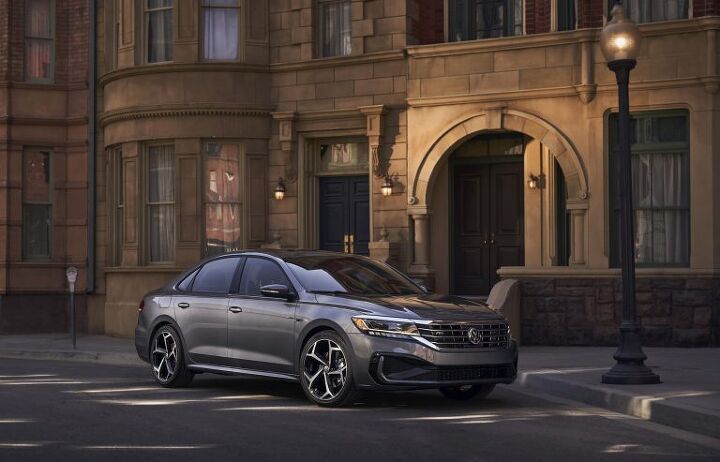Midsize Sedan Demand Is Falling Fast, so What Are Midsize Sedan Prices Doing? They're Rising, and Fast
America’s appetite for intermediate sedans is disappearing, as the queasiness consumers feel when faced with the prospect of buying a family sedan seems to be settled only by the consumption of crossovers.
They go down smooth.
This isn’t news, of course. TTAC began a close, monthly watch of the U.S. midsize sedan sector in August 2016. Since then, the demise of individual midsize nameplates has continued, and the numbers associated with the segment’s sales performance – as we chronicled earlier this month – have grown more frightening.
Yet there are signs that, at least on the retail front, the midsize sedan segment’s American decline could be levelling off. And that moderation is coinciding with something you might not have anticipated: rising average transaction prices.
According to data obtained from J.D. Power, the midsize sedan segment’s share of the automotive industry’s retail sales barely decreased, on a year-over-year basis, in the final quarter of 2018. In fact, December’s flatlining was the closest thing to a retail market share improvement the segment has seen since its share of the market last increased in – get this – the early part of 2013.
Throughout much of 2014, the midsize sedan segment was losing more than 2 percentage points of market share compared with 2013. The sharpness of that market share decline dulled somewhat in 2015 but then grew harsh again, and on a more consistent basis, in 2016. Over the course of much of 2017 and 2018, the segment’s share of the monthly retail market would typically fall by more than 1 percentage point, year-over-year.
That’s a story in and of itself. Perhaps, maybe, possibly, the segment won’t lose 16 percent of its sales in 2019, as it has (fleet-included) in each of the last two years.
But there’s another story tucked within the market share tallies. Automakers are acclimating. It’s clear that predictions of demand restoration brought on by new a new Camry and a new Accord were way off the mark. While Honda and Toyota and numerous others persist, midsize efforts from domestic manufacturers are ceasing or have already ceased. The extraordinarily low volumes generated by some remaining Camry/Accord competitors leave little doubt that others will follow the Mitsubishi Galant, Chrysler 200, and Ford Fusion.
Automakers have caught on. The overwhelming majority of new vehicle buyers don’t want a midsize sedan. “But as midsize cars have been redesigned,” J.D. Power managing director Tyson Jominy says, “OEMs are planning for much lower volumes than before, but with higher margins.”
Average transaction prices in the midsize sedan segment slid less than 1 percent to $21,797 in 2017, according to J.D. Power. Fast forward to 2018, however, and while non-midsize sedan ATPs grew slightly less than 2 percent (to $33,407), the ATP on the average midsize car jumped 7 percent, far outpacing the industry’s price growth.
“The opportunity to find an OEM with a glut of midsize cars that they are desperate to move is drying up very quickly,” Jominy says. As automakers match midsize sedan inventory to demand, incentives decrease and prices rise.
According to Cars.com inventory levels, Honda has less than two months’ supply of Accords; Toyota likely has little more than one month of Camry supply. Those two vehicles account for better than 4 out of every 10 midsize sedan sales in America.
Timothy Cain is a contributing analyst at The Truth About Cars and Driving.ca and the founder and former editor of GoodCarBadCar.net. Follow on Twitter @timcaincars and Instagram.
More by Timothy Cain
Latest Car Reviews
Read moreLatest Product Reviews
Read moreRecent Comments
- Zerofoo The green arguments for EVs here are interesting...lithium, cobalt and nickel mines are some of the most polluting things on this planet - even more so when they are operated in 3rd world countries.
- JMII Let me know when this a real vehicle, with 3 pedals... and comes in yellow like my '89 Prelude Si. Given Honda's track record over the last two decades I am not getting my hopes up.
- JMII I did them on my C7 because somehow GM managed to build LED markers that fail after only 6 years. These are brighter then OEM despite the smoke tint look.I got them here: https://www.corvettepartsandaccessories.com/products/c7-corvette-oracle-concept-sidemarker-set?variant=1401801736202
- 28-Cars-Later Why RHO? Were Gamma and Epsilon already taken?
- 28-Cars-Later "The VF 8 has struggled to break ground in the increasingly crowded EV market, as spotty reviews have highlighted deficiencies with its tech, ride quality, and driver assistance features. That said, the price isn’t terrible by current EV standards, starting at $47,200 with leases at $429 monthly." In a not so surprising turn of events, VinFast US has already gone bankrupt.



































Comments
Join the conversation
Could it be because we have a new Nissan Altima and Volkswagen Passat, and an almost new Honda Accord and Toyota Camry? New models tend to bring up prices.
Thank you sedan apocalypse (and dieselgate). Black Passat GT. Punchy VR6, great DSG, 40 inches of rear legroom, two-tone pleather, (too big) 19" wheels, moonroof, heated seats, heated mirrors, BLIS, rear cross traffic alert, autonomous emergency breaking, dual zone climate, Android Auto / Apple CarPlay, big gas tank, big ol' trunk. 6 year/72k bumper-to-bumper warranty. $24.6k. That's FWD 1.5L Escape SEL money for a roomier car that can do 60 in under 6 seconds and trap over 100mph (Escape is 9.2 seconds and 81mph). I get why people prefer CUVs, but I'm glad there are some comparatively excellent deals to be had in sedan land.